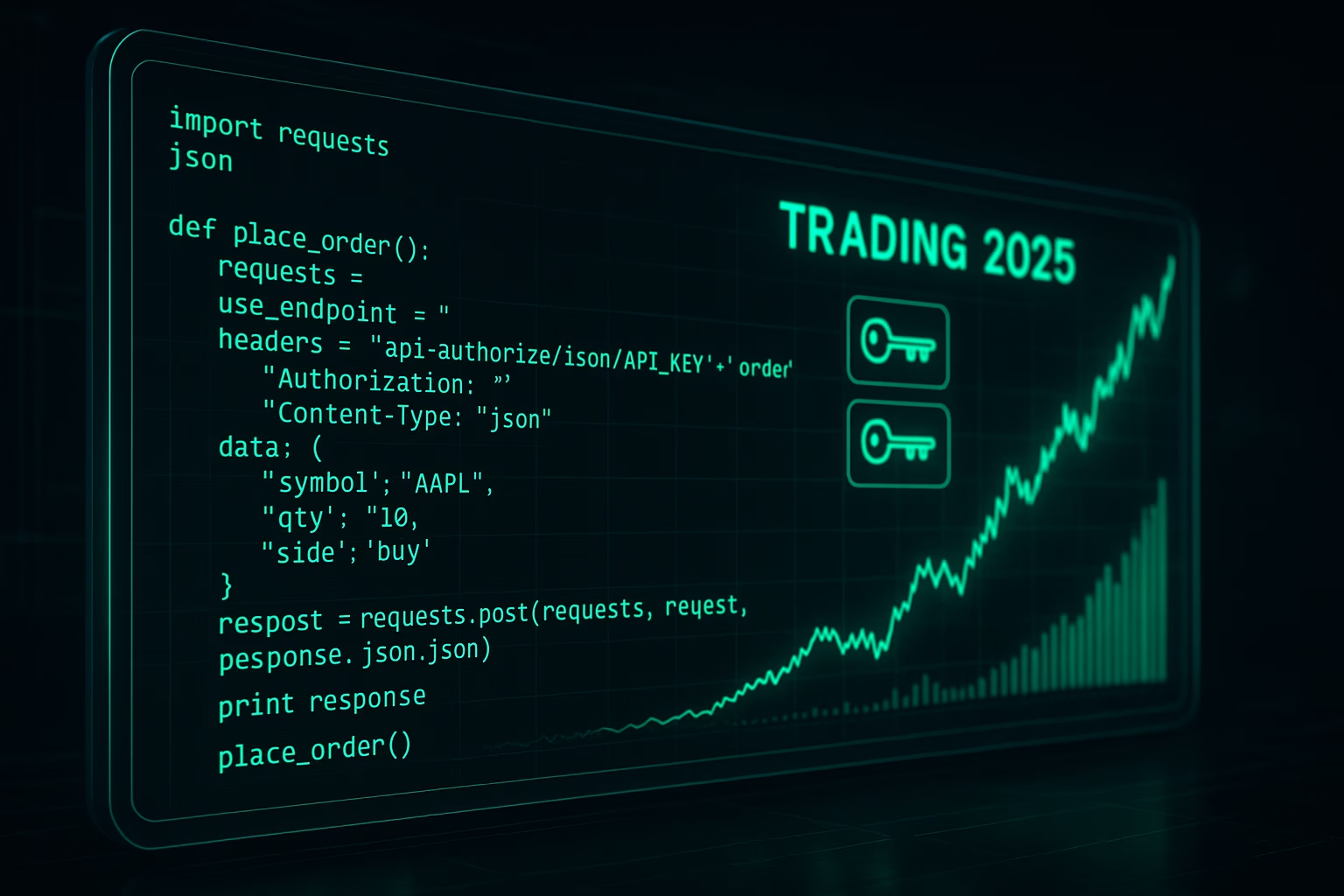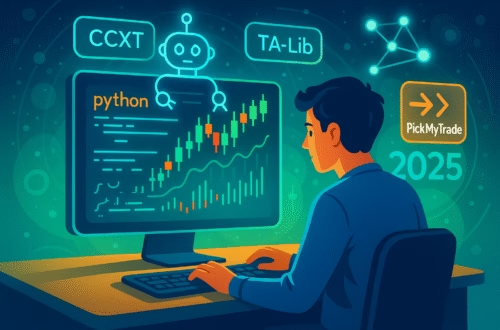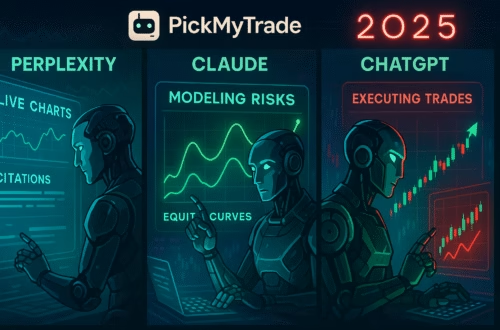In the fast-paced world of 2025 trading, generate trading code that’s efficient, secure, and scalable is no longer optional—it’s essential. With algorithmic trading driving over 80% of market volume, tools like Python scripts and broker APIs empower traders to execute strategies 24/7 without emotional bias. Whether you’re a beginner scripting simple alerts or a pro building AI-driven bots, this guide dives into script generation, API keys, and real code examples. We’ll spotlight recent updates, like Polygon.io’s November 2025 bid/ask size shift to shares and eToro’s public APIs for social trading. Plus, discover how PickMyTrade revolutionizes trading account code automation. Ready to code your edge? Let’s automate.
Why Generate Trading Code in 2025: The Automation Boom
The rise of generate trading code reflects a seismic shift: Retail traders now access institutional-grade tools once reserved for hedge funds. In 2025, APIs from Alpaca and Interactive Brokers enable commission-free, low-latency execution, while AI integrations—like Incoin’s upgraded API with real-time AI assistants—make strategies smarter.
Benefits include:
- Speed: Millisecond trades via WebSockets, outpacing manual orders.
- Scalability: Run multi-asset bots for stocks, forex, crypto, and futures.
- Backtesting: Simulate years of data in hours with libraries like Backtrader.
But success hinges on secure API keys and robust script generation. Poor code? Expect slippage or breaches. Done right? Consistent profits. Recent SEC rules on quote sizes underscore the need for updated code examples compliant with evolving regs.
Secure Your Setup: Managing API Keys for Trading Automation
API keys are your digital passport to brokers—unique strings granting access to data and trades. Mishandle them, and risks skyrocket; secure them, and you’re fortified.
Best Practices for API Keys in 2025
Follow these to lock down your trading account code:
| Practice | Why It Matters | How-To |
|---|---|---|
| Limit Permissions | Prevents full-account hacks | Enable only “read” for data pulls; add “trade” for execution. No withdrawals! |
| Rotate Regularly | Counters leaks from breaches | Generate new keys monthly via broker dashboards like Alpaca’s OAuth. |
| Environment Storage | Avoids hardcoding in scripts | Use Python’s os.environ or tools like dotenv: API_KEY = os.getenv(‘ALPACA_KEY’). |
| IP Whitelisting | Restricts access to your devices | Set in broker settings (e.g., Binance, IBKR) to block unauthorized IPs. |
| 2FA & Monitoring | Adds layers against phishing | Enable on all accounts; audit logs weekly for anomalies. |
In 2025, with rising cyber threats, OAuth flows (e.g., Alpaca’s keyless auth) are trending for seamless, secure generate trading code. Pro tip: Test keys in paper trading first—Alpaca’s free simulator is gold.
Click Here To Start Stock Trading Automation For Free
Script Generation: Building Your First Trading Automation Script
Script generation turns ideas into executable code. Python dominates in 2025 for its libraries: yfinance for data, pandas for analysis, TA-Lib for indicators. No PhD required—start simple, iterate.
Step-by-Step: Generate Trading Code with Python
- Install Essentials: pip install yfinance pandas ta-lib alpaca-trade-api.
- Fetch Data: Pull real-time feeds.
- Define Strategy: E.g., SMA crossover.
- Execute & Monitor: Integrate API keys for live trades.
Recent: EODHD’s Live v2 API now offers extended US stock quotes, perfect for intraday script generation.
Code Examples: Practical Generate Trading Code Snippets
Hands-on code examples for generate trading code. These use Alpaca for execution—swap in your broker.
Example 1: Basic Data Fetch & Signal Generation
Fetch AAPL data, compute SMAs, generate buy/sell signals.
Python
import yfinance as yf
import pandas as pd
import os
# Secure API keys
API_KEY = os.getenv('ALPACA_KEY')
API_SECRET = os.getenv('ALPACA_SECRET')
# Fetch data
data = yf.download('AAPL', start='2025-01-01', end='2025-11-27')
data['Short_SMA'] = data['Close'].rolling(40).mean()
data['Long_SMA'] = data['Close'].rolling(100).mean()
# Generate signals
data['Signal'] = 0
data['Signal'][40:] = np.where(data['Short_SMA'][40:] > data['Long_SMA'][40:], 1, 0)
data['Position'] = data['Signal'].diff()
print(data.tail()) # View signals for **script generation**This outputs a DataFrame with buy (1) signals on crossovers—backtest before live.
Example 2: Automated Trade Execution with API Keys
Submit a market order via Alpaca. Updated for 2025 Options API.
Python
from alpaca_trade_api.rest import REST
import time
api = REST(API_KEY, API_SECRET, base_url='https://paper-api.alpaca.markets') # Paper trading
# Check signal (from Example 1)
if data['Position'].iloc[-1] == 1: # Buy signal
api.submit_order(
symbol='AAPL',
qty=10,
side='buy',
type='market',
time_in_force='gtc'
)
print("Order placed! Monitoring...")
# Risk management: Set stop-loss
api.submit_order(
symbol='AAPL',
qty=10,
side='sell',
type='stop',
stop_price=150.00 # Adjust dynamically
)Run in a loop for 24/7 automation. Add error handling: try-except for API downtimes.
Advanced: Multi-Asset Bot with TA-Lib
Incorporate RSI for overbought/oversold.
Python
import talib
rsi = talib.RSI(data['Close'], timeperiod=14)
buy_signal = rsi < 30 # Oversold buy
sell_signal = rsi > 70 # Overbought sellIntegrate with trading account code for portfolio rebalancing.
Integrating PickMyTrade: No-Code Trading Account Code Automation
For those wary of pure coding, PickMyTrade bridges TradingView alerts to brokers like Tradovate and Rithmic—no API keys or custom script generation needed. In 2025, its updates shine: Auto TP/SL on entry, multi-level exits, and 3M+ trades executed with millisecond precision.
How PickMyTrade Enhances Generate Trading Code
- Webhook Magic: Paste TradingView alerts into PickMyTrade; it handles trading account code execution across accounts.
- Features: Unlimited strategies ($50/month), paper trading, trailing stops.
- 2025 Edge: AI-optimized for futures; supports IBKR for stocks/options/Forex/Futures
Setup: 5 minutes. Free 5-day trial—no card. Ideal hybrid: Use Python for signals, PickMyTrade for flawless automation. Traders report 20-30% slippage reduction in volatile markets.
Recent Updates: 2025 Trading APIs You Can’t Ignore
Stay ahead with these:
- Alpaca’s MCP Server: Natural language trading via AI.
- eToro Open APIs: CopyTrader now US-available; social data feeds.
- Polygon.io Rebrand to Massive: Real-time WebSockets for diversified assets.
- IBKR TWS API: Enhanced for Python, FIX protocol for HFT.
These fuel advanced generate trading code, but always comply with SEC MDI rules.
Conclusion: Code, Automate, Prosper
Mastering generate trading code, API keys, and script generation positions you for 2025’s AI-fueled markets. From simple Python snippets to PickMyTrade’s seamless bots, the tools are here—now execute. Start small, backtest rigorously, and scale. What’s your first strategy? Drop it in comments. Trade smart; code stronger.
FAQs: Most Asked Questions on Generate Trading Code & APIs
Install Python, grab free APIs like Alpha Vantage, and follow our code examples. Paper trade first!
Yes, with limited permissions and rotation. Never share; use env vars.
Alpaca for ease; Polygon for data depth. PickMyTrade for no-code.
Absolutely—ccxt library unifies exchanges. Test with backtraders like Zipline.
Free for basics (Alpaca paper)
Disclaimer:
This content is for informational purposes only and does not constitute financial, investment, or trading advice. Trading and investing in financial markets involve risk, and it is possible to lose some or all of your capital. Always perform your own research and consult with a licensed financial advisor before making any trading decisions. The mention of any proprietary trading firms, brokers, does not constitute an endorsement or partnership. Ensure you understand all terms, conditions, and compliance requirements of the firms and platforms you use.
Also Checkout: Build Profitable Futures Strategy with Claude AI





